MAZDA MODEL CX-9 2018 (in English) Service Manual
Manufacturer: MAZDA, Model Year: 2018, Model line: MODEL CX-9, Model: MAZDA MODEL CX-9 2018Pages: 640
Page 41 of 640

Do not leave a seat belt extender
connected to the buckle:
Leaving a seat belt extender connected to
the buckle without using the seat belt is
dangerous. When the seat belt extender is
connected to the driver's seat belt buckle
(or front passenger's seat belt buckle), the
SRS driver's (or front passenger's) air bag
system will determine that the driver (or
front passenger) is wearing the seat belt
even if the driver (or front passenger) is not
wearing it. This condition could cause the
driver's (or front passenger's) air bag to not
activate correctly and result in death or
serious injury in the event of collision.
Always wear the seat belt with the seat belt
extender.
Do not use the seat belt extender when
installing a child-restraint system on the
front or rear passenger seat:
Using a seat belt extender to fasten a
child-restraint system on any seat is
dangerous. Always follow the
child-restraint system manufacturer's
installation instructions and never use a
seat belt extender.
NOTE
When not in use, remove the seat belt
extender and store it in the vehicle. If the
seat belt extender is left connected, the
seat belt extender might get damaged as it
will not retract with the rest of the seat belt
and can easily fall out of the door when
not in use and be damaged. In addition,
the seat belt warning light will not
illuminate and function properly.
Essential Safety Equipment
Seat Belt Systems
2-29
CX-9_8GC3-EA-17G_Edition12017-5-29 10:13:38
Page 42 of 640
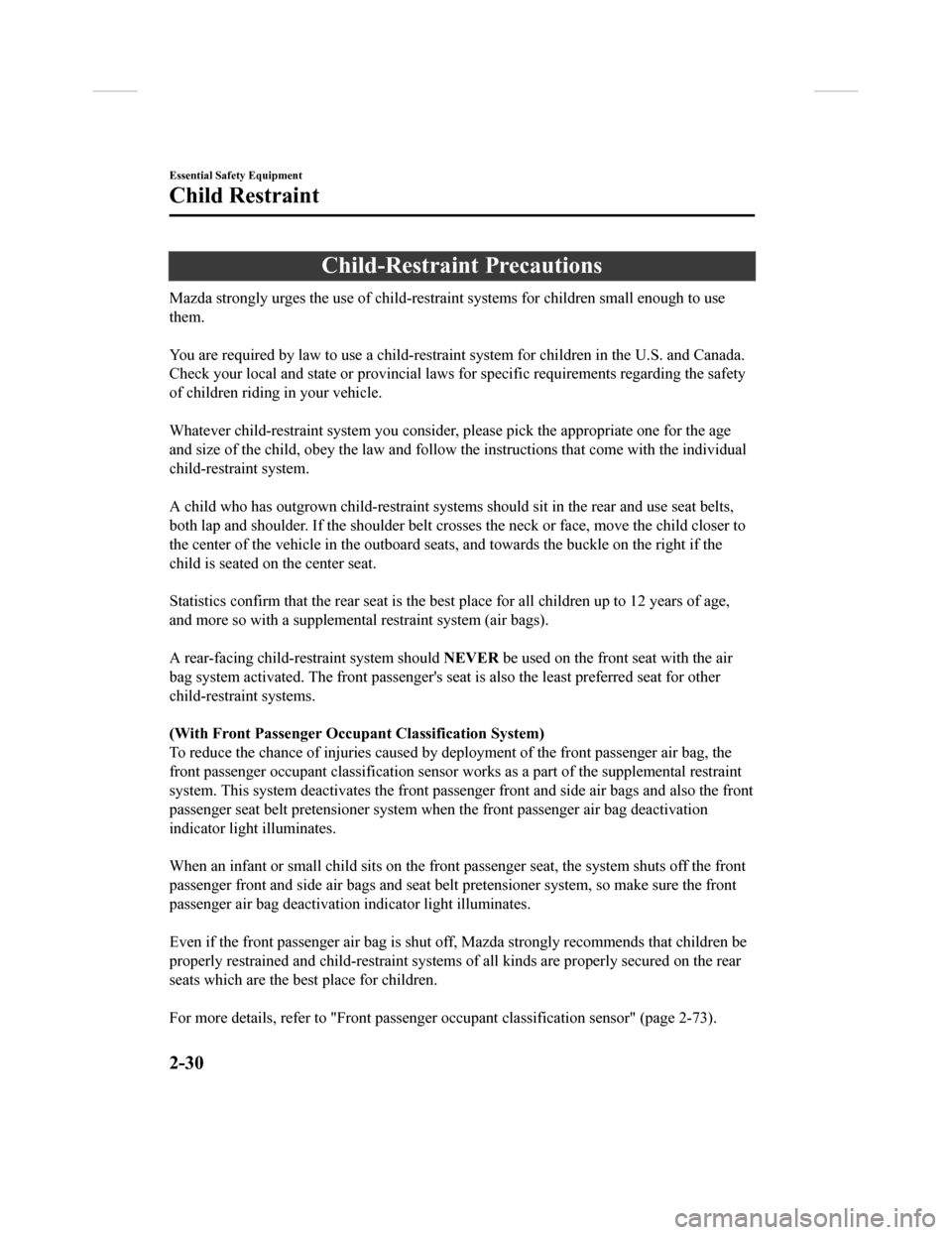
Child-Restraint Precautions
Mazda strongly urges the use of child-restraint systems for children small enough to use
them.
You are required by law to use a child-restraint system for children in the U.S. and Canada.
Check your local and state or provincial laws for specific requ irements regarding the safety
of children riding in your vehicle.
Whatever child-restraint system y ou consider, please pick the appropriate one for the age
and size of the child, obey the law and follow the instructions that come with the individual
child-restraint system.
A child who has outgrown child-r estraint systems should sit in the rear and use seat belts,
both lap and shoulder. If the shoulder belt crosses the neck or face, move the child closer to
the center of the vehicle in the outboard seats, and towards the buckle on the right if the
child is seated on the center seat.
Statistics confirm that the rear seat is the best place for all children up to 12 years of age,
and more so with a supplemental restraint system (air bags).
A rear-facing child-restraint system should NEVER be used on the front seat with the air
bag system activated. The front passenger's seat is also the le ast preferred seat for other
child-restraint systems.
(With Front Passenger Occupa nt Classification System)
To reduce the chance of injuries caused by deployment of the fr ont passenger air bag, the
front passenger occupant classification sensor works as a part of the supplemental restraint
system. This system deactivates the front passenger front and side air bags and also the front
passenger seat belt pretensioner system when the front passenge r air bag deactivation
indicator light illuminates.
When an infant or small child sits on the front passenger seat, the system shuts off the front
passenger front and side air bags and seat belt pretensioner sy stem, so make sure the front
passenger air bag deactivation indicator light illuminates.
Even if the front passenger air bag is shut off, Mazda strongly recommends that children be
properly restrained and child-rest raint systems of all kinds are properly secured on the rear
seats which are the best place for children.
For more details, refer to "Front passenger occupant classification sensor" (page 2-73).
Essential Safety Equipment
Child Restraint
2-30
CX-9_8GC3-EA-17G_Edition1 2017-5-29 10:13:38
Page 43 of 640
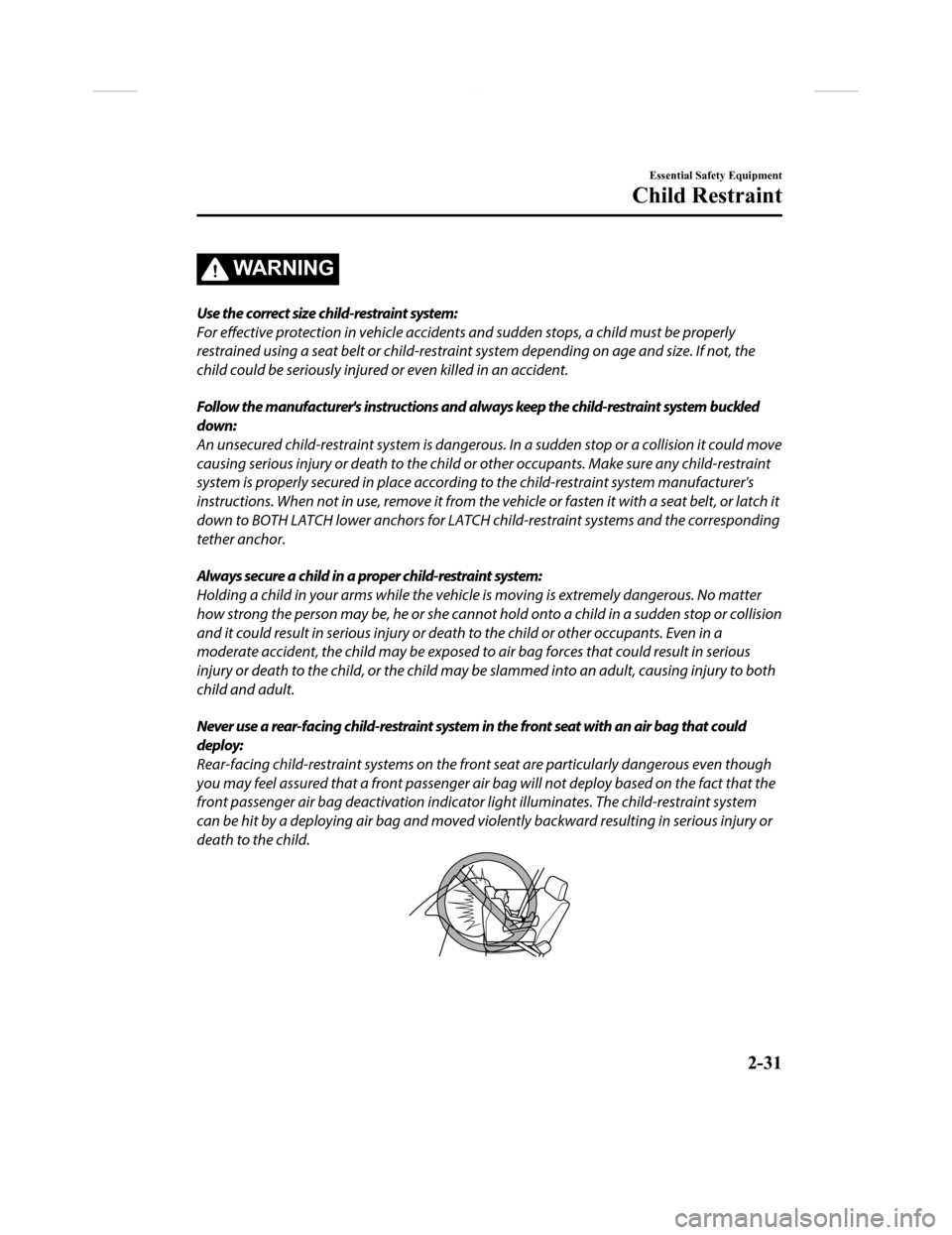
WA R N I N G
Use the correct size child-restraint system:
For effective protection in vehicle accidents and sudden stop s, a child must be properly
restrained using a seat belt or child-restraint system depending on age and size. If not, the
child could be seriously injured or even killed in an accident.
Follow the manufacturer's instructions and always keep the child-restraint system buckled
down:
An unsecured child-restraint system is dangerous . In a sudden stop or a collision it could move
causing serious injury or death to the child or other occupants. Make sure any child-restraint
system is properly secured in place accordin g to the child-restraint system manufacturer's
instructions. When not in use, remove it from the vehicle or fasten it with a seat belt, or latch it
down to BOTH LATCH lower anchors for LATCH child-restraint systems and the corresponding
tether anchor.
Always secure a child in a proper child-restraint system:
Holding a child in your arms while the vehicl e is moving is extremely dangerous. No matter
how strong the person may be, he or she cannot hold onto a child in a sudden stop or collision
and it could result in serious injury or death to the child or other occupants. Even in a
moderate accident, the child may be exposed to air bag forces that could result in serious
injury or death to the child, or the child may be slammed into an adult, causing injury to both
child and adult.
Never use a rear-facing child-restraint system in the front seat with an air bag that could
deploy:
Rear-facing child-restraint systems on the front seat are particularly dangerous even though
you may feel assured that a front passenger air bag will not deploy based on the fact that the
front passenger air bag deactivation indicato r light illuminates. The child-restraint system
can be hit by a deploying air bag and moved viol ently backward resulting in serious injury or
death to the child.
Essential Safety Equipment
Child Restraint
2-31
CX-9_8GC3-EA-17G_Edition1 2017-5-29 10:13:38
Page 44 of 640
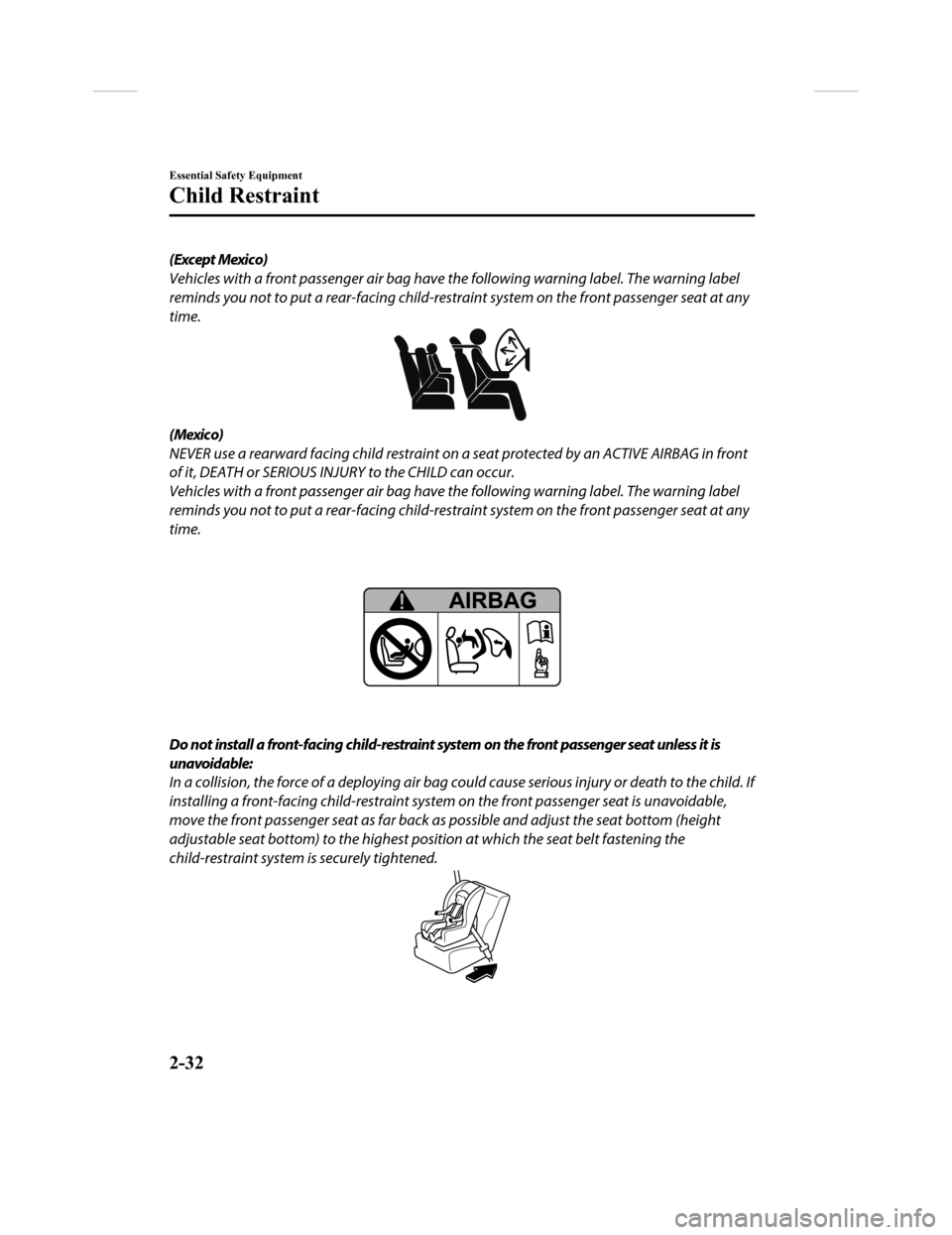
(Except Mexico)
Vehicles with a front passenger air bag have the following warning label. The warning label
reminds you not to put a rear-facing child-restra int system on the front passenger seat at any
time.
(Mexico)
NEVER use a rearward facing child restraint on a seat protected by an ACTIVE AIRBAG in front
of it, DEATH or SERIOUS INJURY to the CHILD can occur.
Vehicles with a front passenger air bag have th e following warning label. The warning label
reminds you not to put a rear-facing child-restra int system on the front passenger seat at any
time.
Do not install a front-facing child-restraint system on the front passenger seat unless it is
unavoidable:
In a collision, the force of a deploying air bag co uld cause serious injury or death to the child. If
installing a front-facing child-restraint system on the front passenger seat is unavoidable,
move the front passenger seat as far back as possible and adjust the seat bottom (height
adjustable seat bottom) to the highest posi tion at which the seat belt fastening the
child-restraint system is securely tightened.
Essential Safety Equipment
Child Restraint
2-32
CX-9_8GC3-EA-17G_Edition1 2017-5-29 10:13:38
Page 45 of 640

Seating a child in a child-restraint system on the front passenger seat is dangerous under
certain conditions (With Front Passenger Occupant Classification System):
Your vehicle is equipped with front passenger occupant classification sensor. Even with the
front passenger occupant classification sensor, if you must use the front passenger seat to
seat a child, using a child-restraint system on the front passenger seat under the following
conditions increases the danger of the front passenger air bag deploying and could result in
serious injury or death to the child.
The front passenger air bag deactivation indicator light does not illuminate when seating a
child in the child-restraint system.
Luggage or other items are placed on the seat with the child in the child-restraint system.
A rear passenger or luggage pushing or pulling down on the front passenger seatback.
Luggage or other items are placed on the seatback or hung on the head restraint.
The seat is washed.
Liquids are spilled on the seat.
The front passenger seat is moved backward, pushing into luggage or other items placed
behind it.
The front passenger seatback contacts the rear seat.
Luggage or other items are placed between the front passenger seat and driver seat.
An electric device is put on the front passenger's seat.
An additional electrical device, such as a seat warmer is installed to the surface of the front
passenger seat.
The designated positions with seat belts on the rear seats are the safest places for children.
Always use seat belts and child restraints.
Do not allow a child or anyone to lean over or against the side window of a vehicle with side
and curtain air bags:
It is dangerous to allow anyone to lean over or against the side window, the area of the front
passenger seat, the front and rear window pillar s and the roof edge along both sides from
which the side and curtain air bags deploy, even if a child-restraint system is used. The impact
of inflation from a side or curtain air bag could cause serious injury or death to an out of
position child. Furthermore, le aning over or against the front door could block the side and
curtain air bags and eliminate th e advantages of supplemental protection. With the front air
bag and the additional side air bag that comes out of the front seat, the rear seat is always a
better location for children. Take special care not to allow a child to lean over or against the
side window, even if the child is seated in a child-restraint system.
Essential Safety Equipment
Child Restraint
2-33
CX-9_8GC3-EA-17G_Edition1 2017-5-29 10:13:38
Page 46 of 640
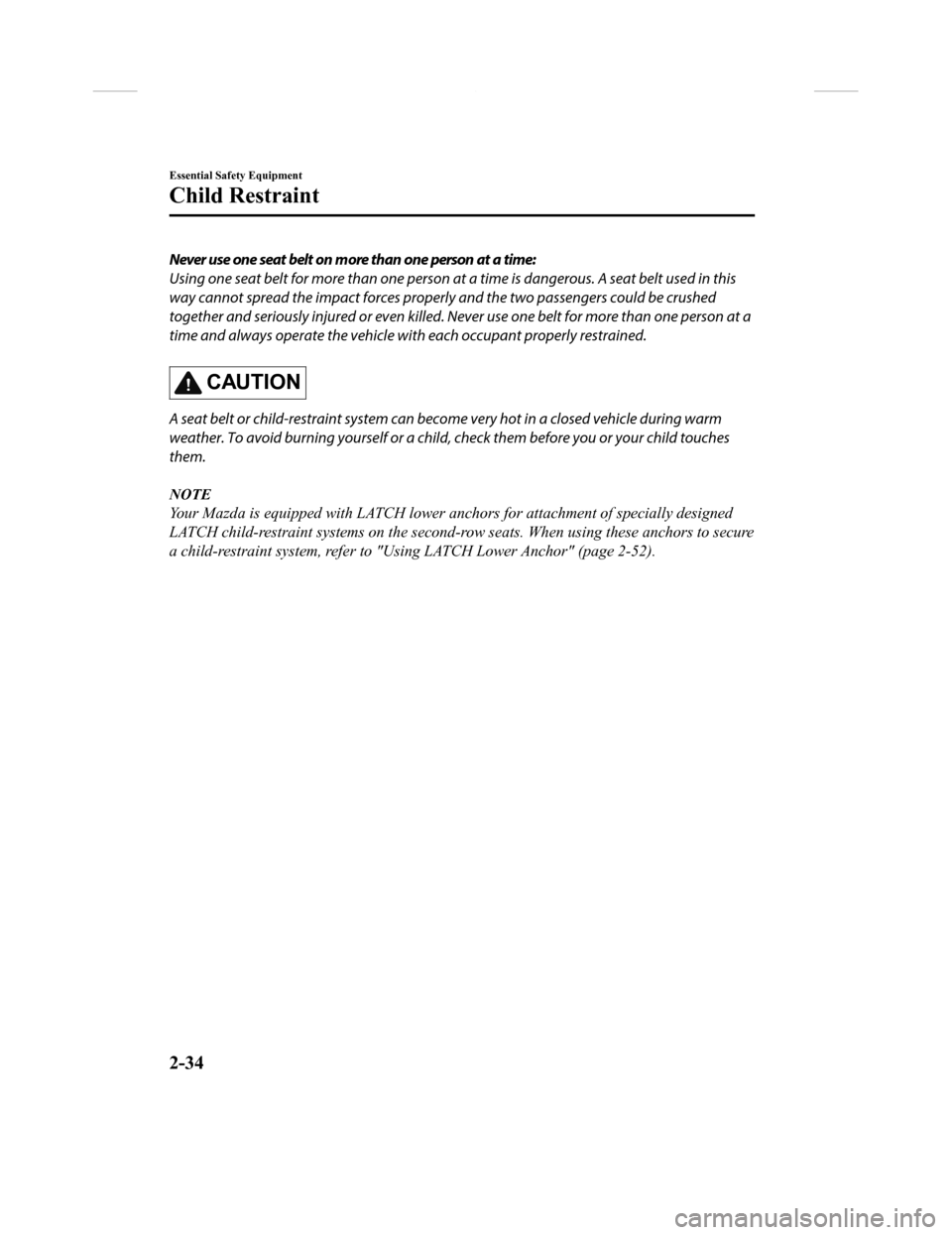
Never use one seat belt on more than one person at a time:
Using one seat belt for more than one person at a time is dangerous. A seat belt used in this
way cannot spread the impact forces properly and the two passengers could be crushed
together and seriously injured or even killed. Never use one belt for more than one person at a
time and always operate the vehicle with each occupant properly restrained.
CAUTION
A seat belt or child-restraint system can become very hot in a closed vehicle during warm
weather. To avoid burning yourself or a child, check them before you or your child touches
them.
NOTE
Your Mazda is equipped with LATCH lower an chors for attachment of specially designed
LATCH child-restraint systems on the second-row seats. When using these anchors to secure
a child-restraint system, refer to "Using LATCH Lower Anchor" (page 2-52).
Essential Safety Equipment
Child Restraint
2-34
CX-9_8GC3-EA-17G_Edition1 2017-5-29 10:13:38
Page 47 of 640
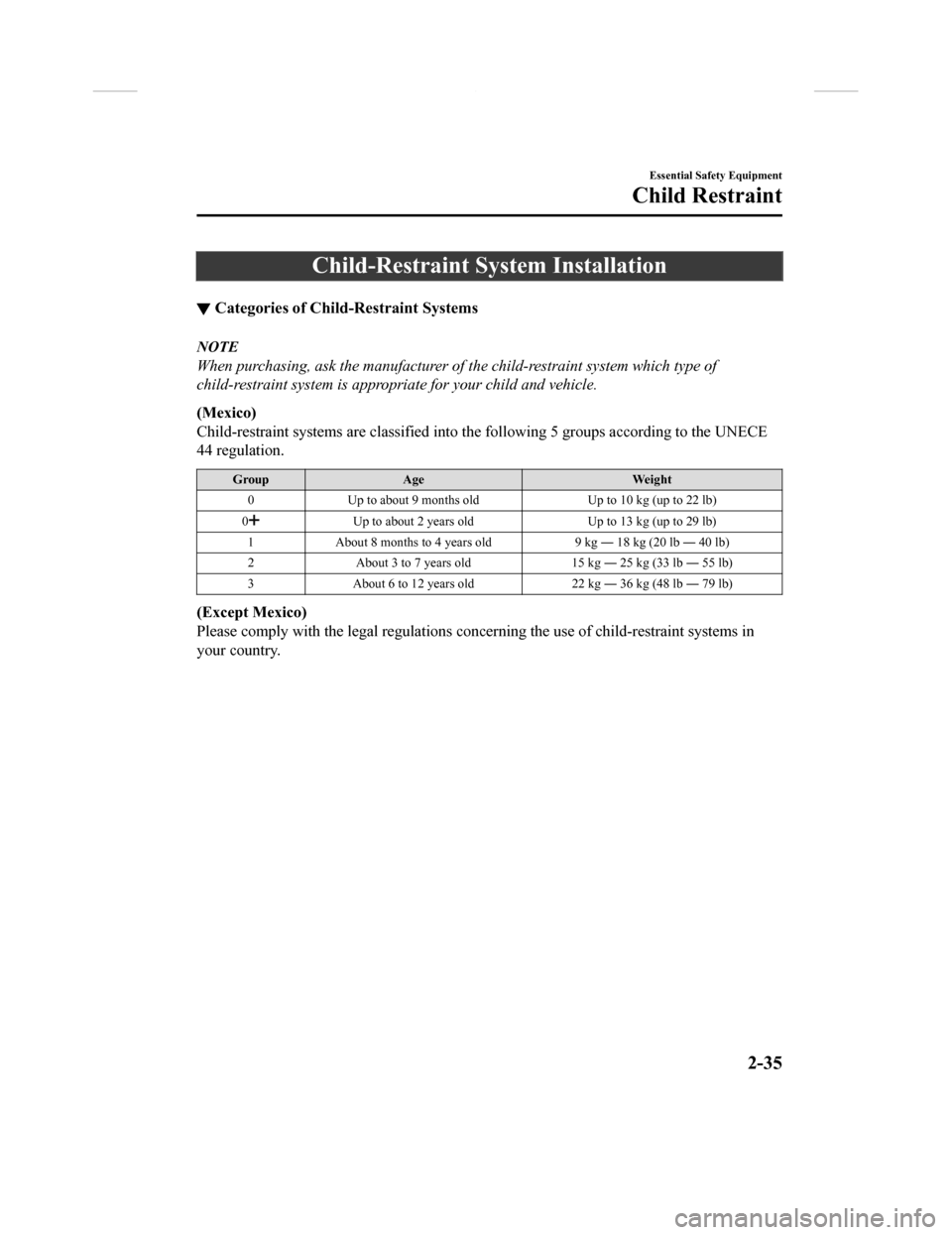
Child-Restraint System Installation
▼Categories of Child-Restraint Systems
NOTE
When purchasing, ask the manufacturer of the child-restraint system which type of
child-restraint system is appropriate for your child and vehicle.
(Mexico)
Child-restraint systems are clas
sified into the following 5 groups according to the UNECE
44 regulation.
Group Age Weight
0 Up to about 9 months old Up to 10 kg (up to 22 lb)
0
Up to about 2 years old Up to 13 kg (up to 29 lb)
1 About 8 months to 4 years old 9 kg ― 18 kg (20 lb ― 40 lb)
2 About 3 to 7 years old 15 kg ― 25 kg (33 lb ― 55 lb)
3 About 6 to 12 years old 22 kg ― 36 kg (48 lb ― 79 lb)
(Except Mexico)
Please comply with the legal regulations concerning the use of child-restraint systems in
your country.
Essential Safety Equipment
Child Restraint
2-35
CX-9_8GC3-EA-17G_Edition1 2017-5-29 10:13:38
Page 48 of 640
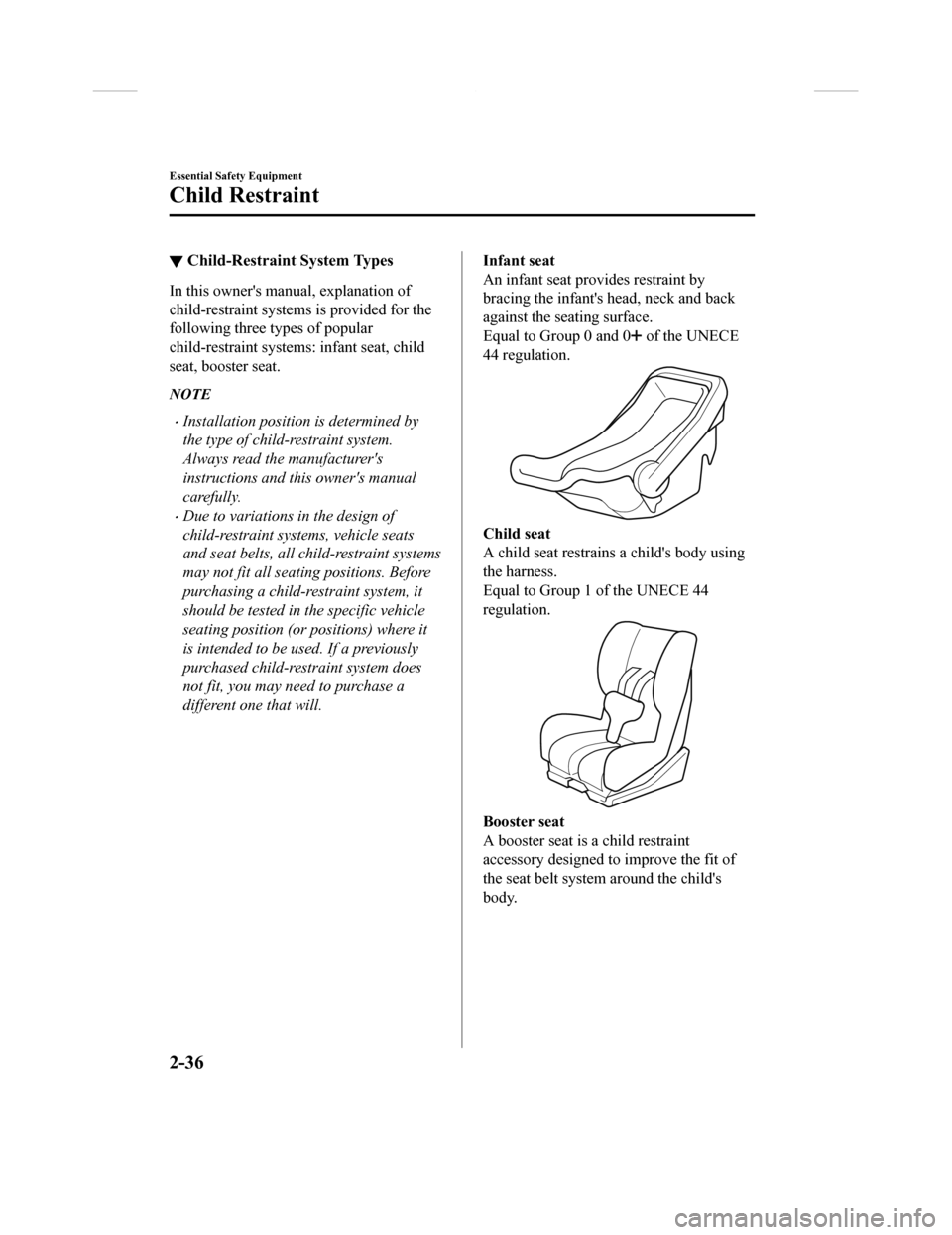
▼Child-Restraint System Types
In this owner's manual, explanation of
child-restraint system
s is provided for the
following three types of popular
child-restraint system s: infant seat, child
seat, booster seat.
NOTE
•Installation position is determined by
the type of child-restraint system.
Always read the manufacturer's
instructions and this owner's manual
carefully.
•Due to variations in the design of
child-restraint systems, vehicle seats
and seat belts, all child-restraint systems
may not fit all seating positions. Before
purchasing a child-restraint system, it
should be tested in the specific vehicle
seating position (or positions) where it
is intended to be used. If a previously
purchased child-restraint system does
not fit, you may need to purchase a
different one that will.
Infant seat
An infant seat provides restraint by
bracing the infant's head, neck and back
against the seating surface.
Equal to Group 0 and 0
of the UNECE
44 regulation.
Child seat
A child seat restrains a child's body using
the harness.
Equal to Group 1 of the UNECE 44
regulation.
Booster seat
A booster seat is a child restraint
accessory designed to improve the fit of
the seat belt system around the child's
body.
Essential Safety Equipment
Child Restraint
2-36
CX-9_8GC3-EA-17G_Edition1 2017-5-29 10:13:38
Page 49 of 640
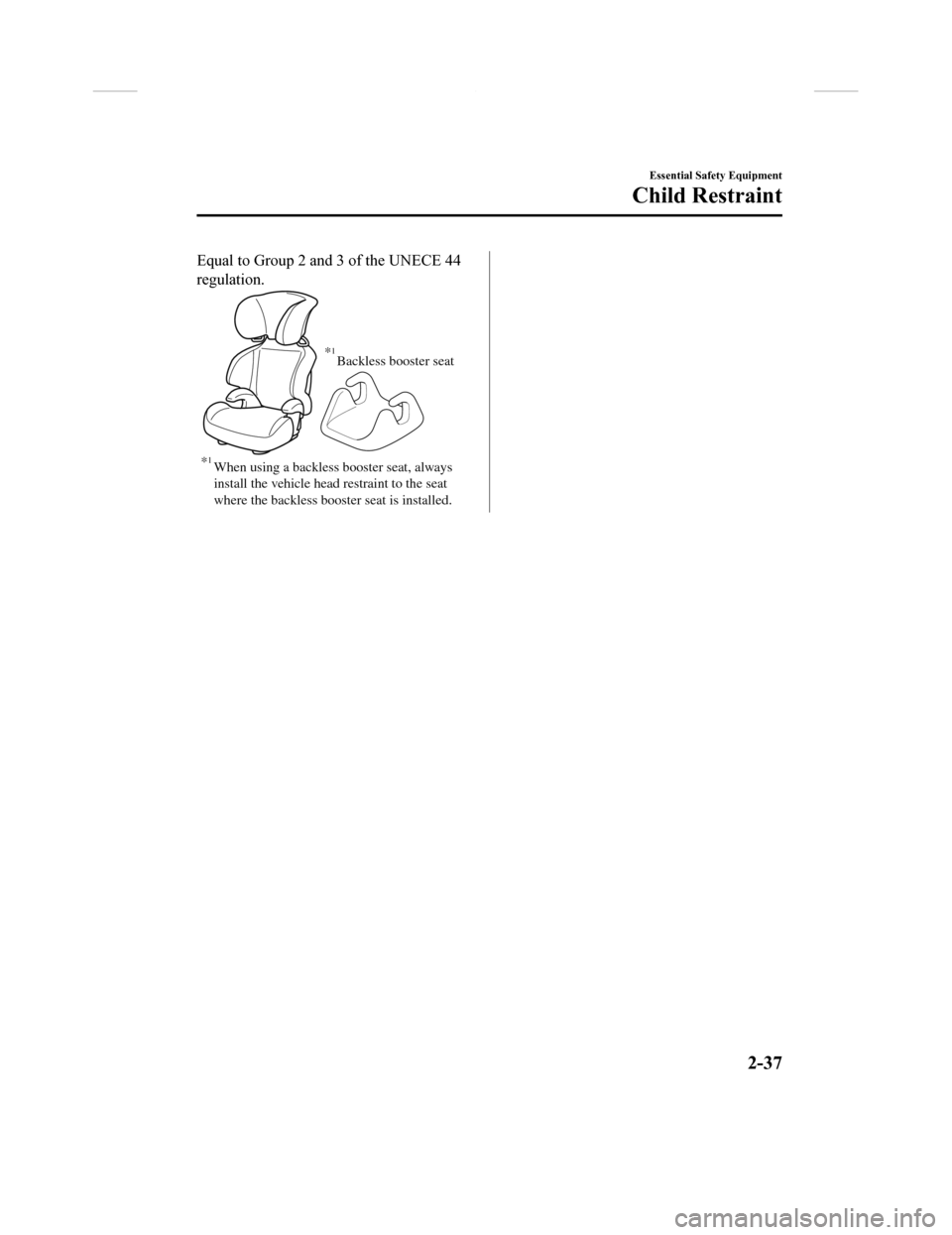
Equal to Group 2 and 3 of the UNECE 44
regulation.
When using a backless booster seat, always
install the vehicle head restraint to the seat
where the backless booster seat is installed.
Backless booster seat
*1
*1
Essential Safety Equipment
Child Restraint
2-37
CX-9_8GC3-EA-17G_Edition1
2017-5-29 10:13:38
Page 50 of 640
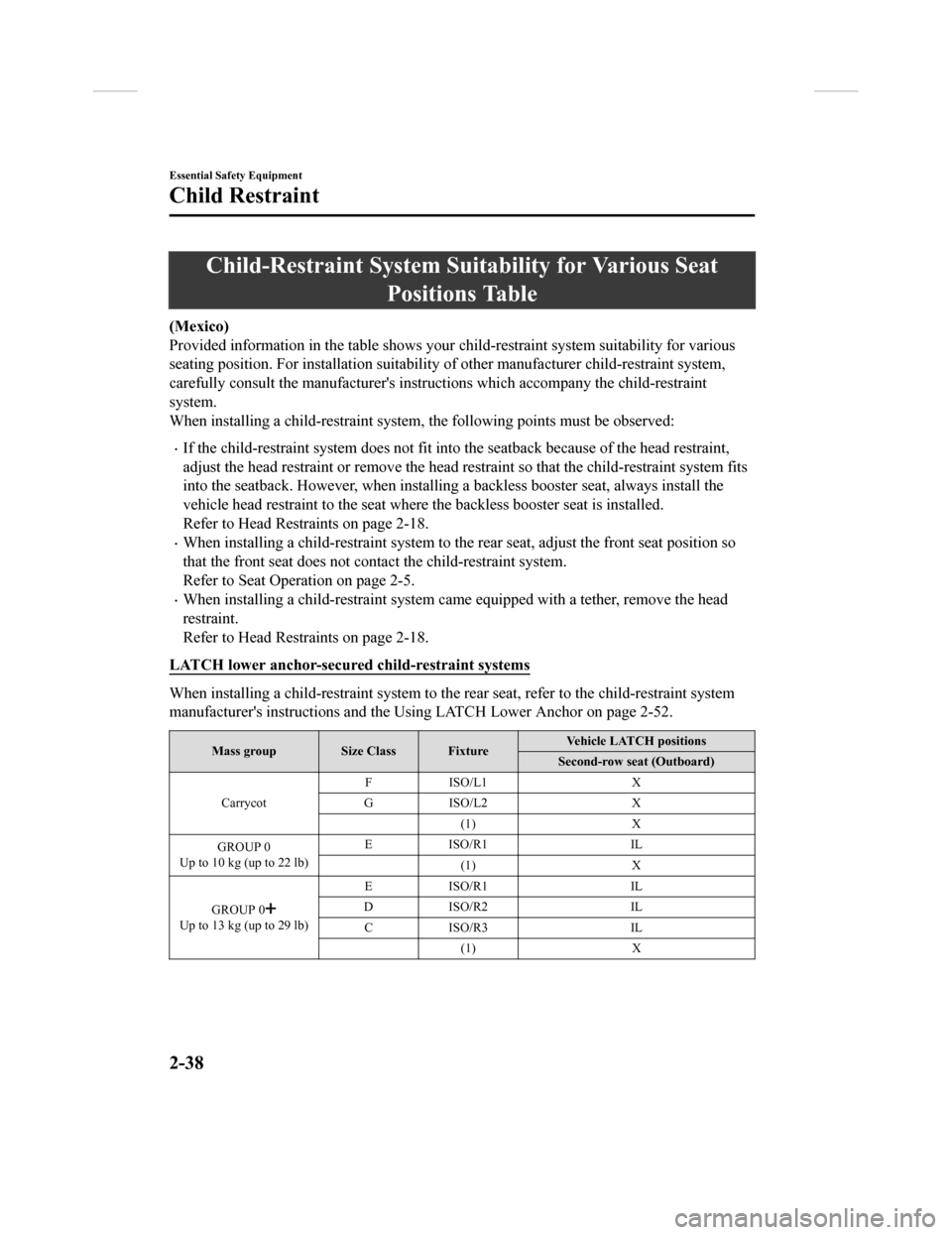
Child-Restraint System Suitability for Various SeatPositions Table
(Mexico)
Provided information in the table shows your child-restraint sy stem suitability for various
seating position. For installati on suitability of other manufacturer child-restraint system,
carefully consult the manufacturer's instructions which accompa ny the child-restraint
system.
When installing a child-restrain t system, the following points must be observed:
•If the child-restraint system doe s not fit into the seatback be cause of the head restraint,
adjust the head restraint or remove the head restraint so that the child-restraint system fits
into the seatback. However, when installing a backless booster seat, always install the
vehicle head restraint to the seat where the backless booster s eat is installed.
Refer to Head Restraints on page 2-18.
•When installing a child-restrain t system to the rear seat, adjust the front seat position so
that the front seat does not cont act the child-restraint system.
Refer to Seat Operation on page 2-5.
•When installing a child-restrain t system came equipped with a t ether, remove the head
restraint.
Refer to Head Restraints on page 2-18.
LATCH lower anchor-secured child-restraint systems
When installing a child-restraint system to the rear seat, refe r to the child-restraint system
manufacturer's instructions and the Using LATCH Lower Anchor on page 2-52.
Mass groupSize Class Fixture Vehicle LATCH positions
Second-row seat (Outboard)
Carrycot FI
SO /L 1 X
GI SO /L 2 X
(1) X
GROUP 0
Up to 10 kg (up to 22 lb) EI
SO /R 1 IL
(1) X
GROUP 0
Up to 13 kg (up to 29 lb) EISO/R1 IL
DI SO /R 2 IL
CI SO /R 3 IL
(1) X
Essential Safety Equipment
Child Restraint
2-38
CX-9_8GC3-EA-17G_Edition1 2017-5-29 10:13:38